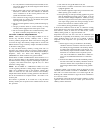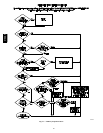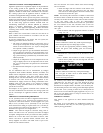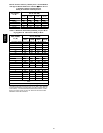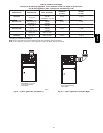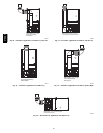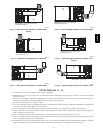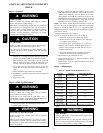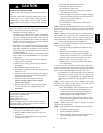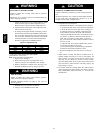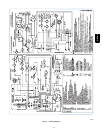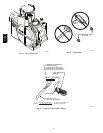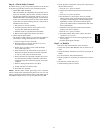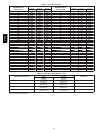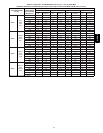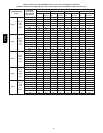
33
FURNACE DAMAGE HAZARD
Failure to follow this caution may result in reduced furnace
life.
DO NOT redrill orifices. Improper drilling (burrs, out--of
round holes, etc.) can cause excessive burner noise and
misdirection of burner flames. This can result in flame
impingement of heat exchangers, causing failures. (See Fig.
43.)
CAUTION
!
Furnace gas input rate on rating plate is for installations at
altitudes up to 2000 ft. (610 M). Furnace input rate must be
within +/--2 percent of furnace rating plate input.
1. Determine the correct gas input rate.
The input rating for altitudes above 2,000 ft. (610 M) must
be reduced by 4 percent for each 1,000 ft. (305 M) above
sea level. For installations below 2000 ft., refer to the unit
rating plate. For installations above 2000 ft. (610 M), mul-
tiply the input on the rating plate by the derate multiplier
in Table 11 for the correct input rate.
2. Determine the correct orifice and manifold pressure adjust-
ment. There are two different orifice and manifold adjust-
ment tables. All models in all positions, except Low NOx
models in downflow or horizontal positions, use Table 15
(22,000 Btuh/Burner).
Low NOx models in the downflow or horizontal positions
must use Table 16 (21,000 Btuh/Burner). See input listed
on rating plate.
a. Obtain average yearly gas heat value (at installed alti-
tude) from local gas supplier.
b. Obtain average yearly gas specific gravity from local
gas supplier.
c. Find installation altitude in Table 15 or 16.
d. Find closest natural gas heat value and specific gravity
in Table 15 or 16.
e. Follow heat value and specific gravity lines to point of
intersection to find orifice size and manifold pressure
settings for proper operation.
f. Check and verify burner orifice size in furnace.
NEVER ASSUME ORIFICE SIZE. ALWAYS
CHECK AND VERIFY.
g. Replace orifice with correct size if required by Table
15 or 16. Use only factory--supplied orifices. See
EXAMPLE 2.
EXAMPLE 2: (0--2000 ft. (0--610 M) altitude)
For 22,000 Btuh per burner application use Table 15.
Heating value = 1000 Btuh/cu ft.
Specific gravity = 0.62
Therefore: Orifice No. 43*
Manifold pressure: 3.7--In. W.C.
*Furnace is shipped with No. 43 orifices. In this example all
main burner orifices are the correct size and do not need to be
changed to obtain proper input rate.
3. Adjust manifold pressure to obtain correct input rate.
a. Turn gas valve ON/OFF switch to OFF.
b. Remove manifold pressure tap plug from gas valve.
(See Fig. 42.)
c. Connect a water column manometer or similar device
to manifold pressure tap.
d. Turn gas valve ON/OFF switch to ON.
e. Manually close blower door switch.
f. Set thermostat to call for heat.
g. Jumper R and W thermostat connections on furnace
control board to start furnace.
h. Remove regulator seal cap and turn regulator adjusting
screw counterclockwise (out) to decrease input rate of
clockwise (in) to increase input rate.
i. Install regulator seal cap.
j. Leave manometer or similar device connected and
proceed to Step 4.
NOTE: DO NOT set manifold pressure less than 3.2--In. W.C. or
more than 3.8--In. W.C. for natural gas at sea level. If manifold
pressure is outside this range, change main burner orifices or refer
Table 15 or 16.
NOTE: If orifice hole appears damaged or it is suspected to have
been redrilled, check orifice hole with a numbered drill bit of
correct size. Never redrill an orifice. A burr--free and squarely
aligned orifice hole is essential for proper flame characteristics.
4. Verify natural gas input rate by clocking meter.
NOTE: Gas valve regulator adjustment cap must be in place for
proper input to be clocked.
a. Turn off all other gas appliances and pilots served by
the meter.
b. Run furnace for 3 minutes in heating operation.
c. Measure time (in sec) for gas meter to complete 1 re-
volution and note reading. The 2 or 5 cubic feet dial
provides a more accurate measurement of gas flow.
d. Refer to Table 13 for cubic ft. of gas per hr.
e. Multiply gas rate (cu ft./hr) by heating value (Btu/cu
ft.) to obtain input.
If clocked rate does not match required input from Step 1,
increase manifold pressure to increase input or decrease manifold
pressure to decrease input. Repeat steps b through e until correct
input is achieved. Reinstall regulator seal cap on gas valve.
5. Set temperature rise. The furnace must operate within the
temperature rise ranges specified on the furnace rating
plate. Do not exceed temperature rise range specified on
unit rating plate. Determine the temperature rise as fol-
lows:
NOTE: Blower access door must be installed when taking
temperature rise reading. Leaving blower access door off will
result in incorrect temperature measurements.
a. Place thermometers in return and supply ducts as close
to furnace as possible. Be sure thermometers do not
see radiant heat from heat exchangers. Radiant heat
affects temperature rise readings. This practice is par-
ticularly important with straight--run ducts.
b. When thermometer readings stabilize, subtract return--
air temperature from supply--air temperature to determ-
ine air temperature rise.
NOTE: Blower access door must be installed for proper
temperature rise measurement.
NOTE: If the temperature rise is outside this range, first check:
S Gas input for heating operation.
S Derate for altitude if applicable.
S Return and supply ducts for excessive restrictions caus-
ing static pressures greater than 0.50--In. W.C.
S Dirty filter.
310AAV



